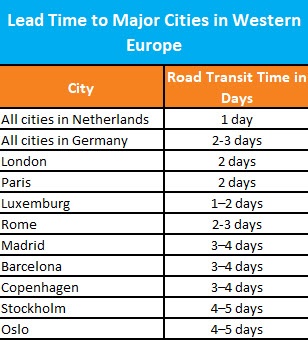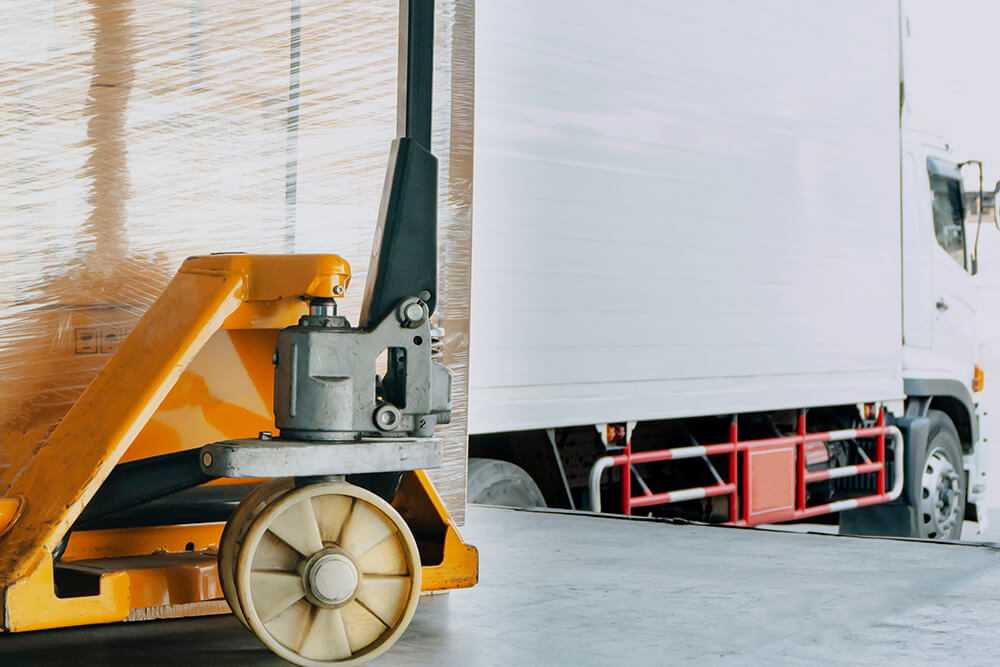Pan European Logistics: Why Choose the Netherlands?
Over 1,000 American and Chinese companies have made the Netherlands their Pan-European logistics and product distribution hub. The reason is simple: money. Because of its central location, the country is Europe’s most cost-effective transportation hub. Furthermore, favorable trade policies allow importers to avoid paying value added tax (VAT) upon importation, significantly improving cash flow. Let’s take a closer look at why your product distribution to European customers should be moved to and via the Netherlands.
Distribute Faster, For Less
The most important reason to establish the Netherlands as your Pan-European logistics hub is to save money on transportation. The country’s impressive port infrastructure includes Rotterdam’s #1 container port and Amsterdam’s #3 cargo airport (Schiphol). A Netherlands DC gives you access to 244 million consumers within 1,000 kilometers for final-mile delivery (see chart on road freight transit times to major European cities). Other important information:
- The Netherlands imports 4x more in value per capita than the other 2 top Western Europe countries, Germany and the UK.
- Germany, France and the UK can be reached in one day, with regular road freight.
- The Netherlands is the leading European location for distribution centers, including the 2nd-largest cooling and freezing storage capacity in the EU.
- Another factor that aids international trade is that the Dutch are a multi-lingual people. In addition to the native language, over 90% speak English and most are conversational in a third language.

To improve cash flow, avoid VAT payments.
When entering a foreign market, you are usually required to pay taxes and duties to the tax authorities at the time of clearance. However, the Netherlands offers VAT deferment in order to improve cash flow.
In the absence of this benefit, importers must pay 21% VAT on non-food items, which is refunded at the end of the tax period. However, this refund can take anywhere from a few months to more than a year. Based on Article 23 of the Dutch Tax regulations, the Netherlands’ “VAT deferment” system allows you to defer paying VAT on imports until your periodic VAT return. VAT must be declared at that time, but it can be deducted in the same return, effectively avoiding the need to pay these taxes. That is a compelling reason to locate a Pan-European logistics hub in the Netherlands.

Other EU countries, such as Germany, Ireland, Italy, Spain, and Sweden, do not practice delayed accounting. Only Belgium has a comparable arrangement.
When shipping goods to and through the Netherlands, it is not necessary to establish a local legal entity. Importers can work with a fiscal representative who will clear Customs and handle all VAT obligations on behalf of the non-European shipper (VAT declarations, listing and paying VAT). Dimerco, for example, acts as the fiscal representative for both American and Chinese companies seeking to import into the Netherlands to take advantage of the country’s favorable tax treatment.
The formula for deferring VAT on a $1 million USD import shipment is $1 million + import duty x 21% VAT. If the import duty on this purchase was 0%, the importer would keep $21,000 USD – just on this one shipment. The ongoing cash flow advantage for a frequent shipper would be significant.
Goods imported into the Netherlands and shipped to customers in other EU countries can circulate free of VAT within the EU, resulting in a very cost-effective Pan-European logistics strategy. For a Dimerco shipment, the procedure might be as follows:
- Seller/shipper sends out invoice to buyer (consignee) in Italy
- Dimerco Netherlands applies for VAT deferment and ships goods to consignee.
- If the 1st buyer in Italy sells the goods to a 2nd buyer in Germany, the invoice would be sent directly to the 2nd buyer and the goods will go, via Dimerco Netherlands, to the German buyer, with the 1st buyer never physically receiving goods.
- VAT will only be paid once, by the end-user / consumer where the final sale is made.
The New Silk Road Boosts Trade from China to Europe
There are numerous options for transporting cargo from China to Europe.
Goods shipped by ocean container to Rotterdam can be deconsolidated and shipped by road freight to end customers throughout Europe within days.
With all of the COVID-related supply chain challenges, rail freight transportation from China to Europe has grown in popularity. This cross-border option can reduce transit time by 20 days compared to ocean freight and can be up to 30% less expensive than air freight.
Air freight from China takes 1–3 days door to door via Amsterdam, depending on the final destination, for high-value products that need to get to market quickly. The map below depicts the transit time for air + truck routes through Amsterdam for pan-European distribution.

There is no scarcity of 3PL support for pan-European logistics.
In Europe, the Netherlands has the highest concentration of logistics service providers. Foreign companies can use 3PL capabilities in the Netherlands for supply chain design, global freight forwarding, customs clearance, warehousing, last-mile distribution, and a variety of other services.
Dimerco established its first office in the Netherlands in 2000, and it now has offices in Amsterdam (Schiphol Airport), Rotterdam, and Venlo. Let’s start a conversation if you’re looking for a global 3PL that can provide your company with Pan-European logistics support from the Netherlands.

